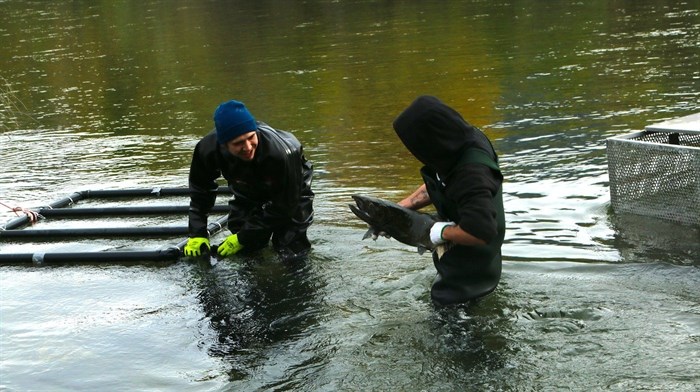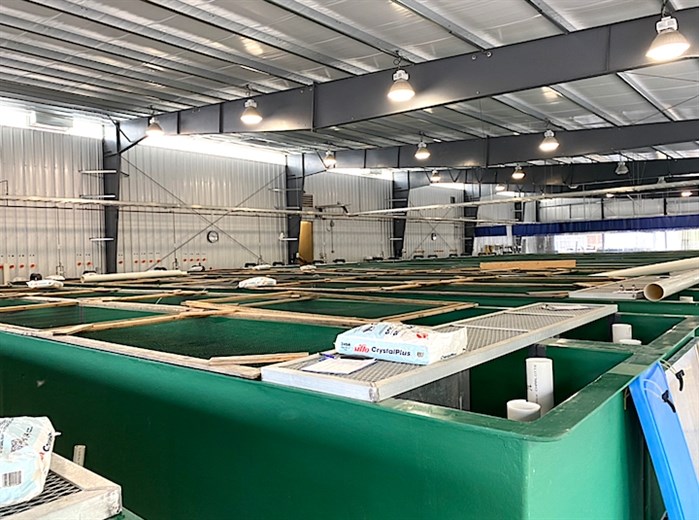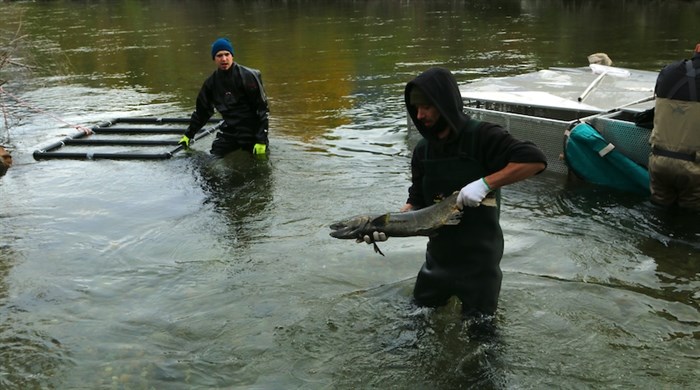
A Broodstock crew member holds up a 20 pound male chinook, in Oliver.
Image Credit: Athena Bonneau, Local Journalism Initiative Reporter
November 11, 2020 - 2:00 PM
The first day that sockeye salmon were reintroduced into the Penticton Channel was a “really good day,” explains Herb Alec, the Penticton Indian Band hatchery building operator.
“People were crying and it was a really emotional day.”
Since May 2004, the Okanagan National Alliance (ONA) has been releasing salmon back into Okanagan rivers and lakes to replenish the salmon population.
ONA’s first release was in the range of 350,000 sockeye salmon and more recently, it’s been as high as 4.2 million sockeye salmon.
This year is on track to be the best return yet.
“The current run forecast estimates that we could see one of the highest returns of sockeye since the reintroduction program began in 2004,” states a press release from ONA.
“We’re estimating about 125,000 to 150,000 [salmon returning] in the Oliver area and between 5,000 and 15,000 in the Penticton channel area,” says Howie Wright, ONA Fisheries Program Manager.
However, with some of the more recent walks that ONA has done, it might be higher in the Penticton area, he says.
ONA will then take no more than 10 per cent of sockeye salmon returning to fertilize for the following year.
How they do it

Technicians are catching salmon in a netting system before transferring them to the holding cage in Oliver.
Image Credit: Athena Bonneau, Local Journalism Initiative Reporter
The ONA — which represents Okanagan Indian Band, Upper Nicola Band, Westbank First Nation, Penticton Indian Band, Osoyoos Indian Band and Lower and Upper Similkameen Indian Bands and the Colville Confederated Tribes — has been working specifically on salmon restoration since 2004.
Today, the work is done through their broodstock and hatchery programs.
The technicians catch salmon through a netting system and then transfer them into a holding cage for bio-sampling and milt (the semen of a male fish) collection.
Snow has been working in salmon restoration programs for 19 years. This year the ONA has set it up differently, he explains.

Broodstock crew members are working together to collect biosamples and milt from male salmon.
Image Credit: Athena Bonneau, Local Journalism Initiative Reporter
“We’re taking all the females live to our hatchery, and they get processed out at the hatchery.”
The kl cp??lk? stim? Hatchery is located on Penticton Indian Band, it opened in 2014. The facility is 25,000 square feet and has the capacity to rear 8 million eggs.
The broodstock collection sticks to a small section of river in Oliver B.C.
“There’s a huge amount of spawning habitat in this part of the river; we only impact [one] area, and the rest is pretty much untouched for spawning,” Snow says.

The Process of transferring the salmon from the netting system to the holding cage in Oliver.
Image Credit: Athena Bonneau, Local Journalism Initiative Reporter
In their natural habitat, the egg survival rate is low. Naturally it’s four per cent or six per cent “if they’re really lucky,” says Snow. But for fish that are created through the broodstock program and then hatched at the hatchery the success rate is about 30 per cent at minimum, he says.
“The survival rate is excellent cause they’re bigger, stronger when they’re released and so it helps increase their population,” Snow says. “In the hatchery, they don’t have to struggle for food, they feed well, so they get bigger faster.”
Once ONA releases salmon into the Okanagan channel, in Penticton. The salmon will migrate down into Shaka Lake for one year, in their nursery. After a year, they swim down to the Columbia river, and then to the ocean where they will live for three years. From that time they’ll start migration, traveling all the way up to Alaska, heading out towards Japan. Afterwards, they will migrate their way back to the Okanagan, according to Wright.
The program revolves mostly around sockeye salmon. But in 2016, they began collecting chinook eggs from the Chief Joseph hatchery from the Colville Tribe, in Malott Washington and releasing them in the Okanagan, as a ceremonial release.

Inside the hatchery, located on the Penticton Indian Band.
Image Credit: Athena Bonneau, Local Journalism Initiative Reporter
That changed this year when they collected three wild chinook salmon. This will be the first time the hatchery will be fertilizing and hatching chinook eggs harvested from the Okanagan River. They will be releasing them in the coming year.
Why it matters
Before the hatchery’s opening, the numbers of sockeye salmon decreased; they did not have the habitat needed for survival due to the massive channelization says Alec.
“There was no way for us to get them back,” he explains.
The ONA believes it is essential to replenish the stock of salmon, so Okanagan Nation members will have salmon to eat for future generations.

Broodstock crew member holds a male chinook caught in the netting system.
Image Credit: Athena Bonneau, Local Journalism Initiative Reporter
“When the fish comes back, the culture comes back,” says Alec.
Restoring salmon is particularly important because “the Okanagan Nation has never signed treaties, nor relinquished our right to harvest and manage the fishery,” the ONA website explains.
“Some of the people call it a responsibility for the Okanagan [people] to [bring the salmon back], and we are helping move forward that responsibility,” says Wright.
— This story was originally published in The Discourse on Oct. 27, 2020.
News from © iNFOnews, 2020